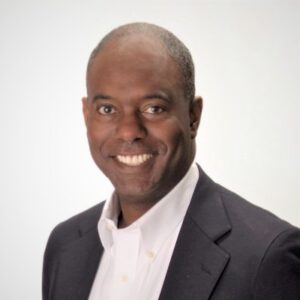 Vice President of Community Health and Engagement at Hartford Healthcare Greg Jones is committed to fostering a healthy community and creating opportunities to diversify organizational talent.
Vice President of Community Health and Engagement at Hartford Healthcare Greg Jones is committed to fostering a healthy community and creating opportunities to diversify organizational talent.
Greg was a recent panelist at Elevating Diverse Talent within Your Organization, a webinar hosted by the MetroHartford Alliance (MHA) and the Racial Equity and Economic Development Committee, where his takeaway strategies were, “Be bold. Be intentional. Don’t overthink.”
MHA Content Manager Nan Price followed up with Greg to learn more.
NAN PRICE: Tell us about your title. What exactly does it mean?
GREG JONES: The title speaks to how we at Hartford HealthCare engage with our community to co-develop programs with the intent of improving the health and wellness of our community. That means creating specific and substantive programs that relate to all the things that make our lives better, including addressing food insecurity and mental health, among other social determinants and influencers of health. Ideally, our programming would provide mutual benefits: improve the overall health of our community and create a more efficient, effective, and responsive health system.
NAN: Can you provide some of examples of how Hartford HealthCare improves our community?
GREG: In 2019, Hartford HealthCare’s Hartford Region partnered with Wholesome Wave, a leading charitable provider of supplemental produce, to fund the Wholesome Wave’s Wholesome Communities Connecticut initiative in Hartford, a first for partnership between a health system and Wholesome Wave. The initiative provides financial support to help people in the Hartford area buy produce each month to supplement their home meals. The idea is to improve health outcomes by focusing on healthy food consumption.
We’ve also created educational and informational programs to address mental health. Our Mental Health First Aid educational seminars train people to be aware of mental health-related crises. We want people to be mental health advocates and encourage people to seek help when they realize there may be challenges within their normal, everyday living. Our goal is the help de-stigmatize mental health and encourage open discussions around the topic.
And Hartford HealthCare has been engaging with the community vaccine center. When we started talking about underserved communities and African-American and Latino communities and their hesitation about getting vaccines, my hypothesis was that it was really about access and equity because their hesitation was all theoretical. People were talking about not getting a vaccine before a vaccine was even developed. Once we developed vaccines, we saw a high reception of vaccination rates among the most underserved when we made the vaccine and vaccination centers easily accessible through neighbor clinics among other sites.
We looked at opening neighborhood clinics similar to how retailers pursue customers: placing centers close to and in the market you’re seeking to address. Retailers go to where the people are, so we needed to go where the people were to get them to accept the vaccine. Most like to do things in their own community. So, we set up a series of neighborhood clinics and we saw a higher percentage of uptake relative to vaccinations.
It really was all about access and equity, which is what our whole healthcare model is all about. It goes back to your question about what community health and engagement means. It’s about knocking down barriers and fighting for equity and access.
NAN: That’s a good segue into talking about DE&I. During the Elevating Diverse Talent within Your Organization webinar, you noted that we need to develop platforms for diverse talent to be recognized and provide opportunities. How can we provide those kinds of opportunities?
GREG: I love the platform, pun intended, to talk about why we need platforms. I believe in the concept that talent is universal but opportunities are not.
We need to be very aggressive, intentional, and purposeful in addressing the issue of DE&I. Over the last few years, we’ve developed systems and processes that prevent talent of some from being realized. We’ve made it very convoluted and bureaucratic, and we often don’t get a chance to recognize talent because processes are taking over substance.
My suggestion is to develop platforms that enable people to shine. And when I say platforms, I mean opportunities. We need to de-risk our own mentality about seeing whether someone is ready for an opportunity—it’s pre-judging people without giving them a chance. When you do that, you minimize the opportunity to engage.
Instead, we need to develop platforms—or opportunities—to showcase all types of people. Give people the opportunity to express themselves so they can see the opportunity.
Sometimes, companies in general are hesitant to discuss metrics and goals related to DE&I. In business we measure everything. We should be equally as interested in setting goals and numbers relative to recruitment, development, and promotion of African Americans, Latinos, and others who have been traditionally underrepresented. We need to constantly think about new people creating opportunities and programs and new projects. We must be intentional in creating equity, which is different than equality.
I think every organization should have development pipelines. If I come into an organization as an entry-level person, theoretically, I should be able to see myself to a senior level position and leader. If your organization doesn’t have something similar to a development pipeline, you’re doing a disservice to your colleagues and not allowing them to provide substantive value to the organization.
An organization’s development pipeline needs to allow individuals to see the highest position in the organization they might be able to ascend to—then it’s up to them to try to work for it and for the organization to help support their interest. It’s a win-win. Improved retention, productivity, and overall better work environment.
Learn more about Hartford HealthCare
hartfordhealthcare.org | Facebook | Instagram | LinkedIn | Twitter
